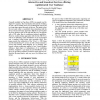Free Online Productivity Tools
i2Speak
i2Symbol
i2OCR
iTex2Img
iWeb2Print
iWeb2Shot
i2Type
iPdf2Split
iPdf2Merge
i2Bopomofo
i2Arabic
i2Style
i2Image
i2PDF
iLatex2Rtf
Sci2ools
ICMCS
2000
IEEE
2000
IEEE
An Extensible Set-Top-Box Architecture for Interactive and Broadcast Services Offering Sophisticated User Guidance
Currently available Set-Top-Boxes (STBs) are mainly used for digital TV reception. The User Interface (UI) and the UI dialog of such a device usually focus on its technological aspects and to a large degree ignore the needs of the user. The impact is that the user quite often is unsatisfied when interacting with the device. Recent UI design approaches [9][10] are proving that the focus should be put on the tasks that the user can perform with a STB rather than its underlying technical capabilities. However, modern design approaches both for the STB UI as well as its underlying system architecture can be incorporated into a complete system design with reasonable effort. This paper presents the architecture of the “d-box”, a STB being used for broadcasting TV services as well as future interactive services like internet, home-shopping etc. in Germany. The layered software architecture employs a Java Virtual Machine offering a high degree of independency of its underlying hardware. E...
ICMCS 2000 | Multimedia | STB UI | UI Dialog | User |
| Added | 31 Jul 2010 |
| Updated | 31 Jul 2010 |
| Type | Conference |
| Year | 2000 |
| Where | ICMCS |
| Authors | Frank Lonczewski, Rudolf Jaeger |
Comments (0)

